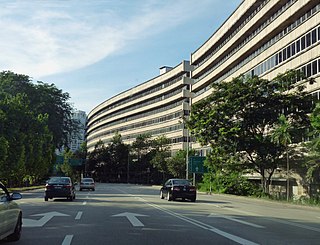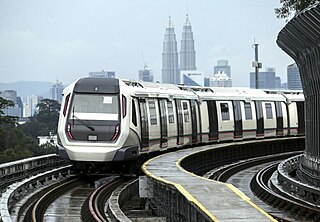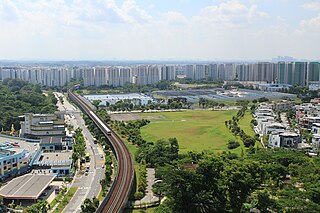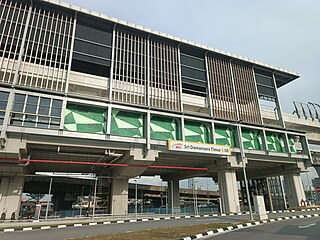
The West Japan Railway Company, also referred to as JR West, is one of the Japan Railways Group companies and operates in western Honshu. It has its headquarters in Kita-ku, Osaka. It is listed in the Tokyo Stock Exchange, is a constituent of the TOPIX Large70 index, and is also one of only three Japan Railways Group constituents of the Nikkei 225 index: the others are JR East and JR Central. It was also listed in the Nagoya and Fukuoka stock exchanges until late 2020.

Kuala Lumpur Sentral Station is a transit-oriented development that houses the main railway station of Kuala Lumpur, the capital of Malaysia. Opened on 16 April 2001, KL Sentral replaced the old Kuala Lumpur railway station as the city's main intercity railway station. KL Sentral is the largest railway station in Malaysia, and also in Southeast Asia from 2001 to 2021, before Krung Thep Aphiwat Central Terminal in Bangkok, Thailand was completed.

Rail transport in Singapore mainly consists of a passenger urban rail transit system spanning the entire city-state: a rapid transit system collectively known as the Mass Rapid Transit (MRT) system operated by the two biggest public transport operators SMRT Trains and SBS Transit, as well as several Light Rail Transit (LRT) rubber-tyred automated guideway transit lines also operated by both companies. In addition, local specialised light rail lines are in operation in places such as the Singapore Changi Airport and Sentosa.

Rapid KL is a public transportation system owned by Prasarana Malaysia and operated by its subsidiaries Rapid Rail and Rapid Bus. The acronym stands for Rangkaian Pengangkutan Integrasi Deras Kuala Lumpur, which translates to Kuala Lumpur Rapid Integrated Transport Network in the Malay language. Rapid KL, with its 204.1 km (126.8 mi) of metro railway and 5.6 km (3.5 mi) of BRT carriageway, is part of the Klang Valley Integrated Transit System, operating throughout Kuala Lumpur and Selangor's satellite cities in the Klang Valley area.

Pusat Bandar Damansara is a township in the Segambut constituency of Kuala Lumpur, Malaysia. The original buildings making up the township were constructed between 1981 and 1984, and were demolished in 2016 for new development.

Bandar Sri Damansara is a residential township in Petaling District, Selangor, Malaysia. The township is divided into two sections, SD1-SD5 in the north and SD7-SD15 in the south which are separated by Kuala Selangor-Kepong Highway. It is adjacent to Kepong and Sungai Buloh. The township consists of mixed development of commercial and residential properties. It was previously developed by Land and General Berhad and currently by TA Global.

Rail transport in Malaysia consists of heavy rail, light rapid transit (LRT), mass rapid transit(MRT), monorails, airport rail links and a funicular railway line. Heavy rail is mostly used for intercity services and freight transport as well as some urban public transport, while rapid transit rails are used for intracity urban public transport in the capital city of Kuala Lumpur and the surrounding Klang Valley region. There are two airport rail link systems linking Kuala Lumpur with the Kuala Lumpur International Airport (KLIA) and Sultan Abdul Aziz Shah Airport. The only-functioning monorail line in the country is also used for public transport in Kuala Lumpur, while the only funicular railway line is available in Penang.

Hatabu Station is a passenger railway station located in the city of Shimonoseki, Yamaguchi Prefecture, Japan. It is operated by the West Japan Railway Company. The station is adjacent to Hatabu Switchyard of Japan Freight Railway Company

The MRT Kajang Line, previously known as the MRT Sungai Buloh–Kajang Line, is a Mass Rapid Transit (MRT) line servicing the Klang Valley, Malaysia. It is the second fully automated and driverless rail system in the Klang Valley region after the LRT Kelana Jaya Line. Owned by MRT Corp and operated as part of the Rapid KL system by Rapid Rail, it forms part of the Klang Valley Integrated Transit System. The line is numbered 9 and coloured green on official transit maps.

The MRT Putrajaya Line, is the second Mass Rapid Transit (MRT) line in Klang Valley, Malaysia, and the third fully automated and driverless rail system in the country. It was previously known as the MRT Sungai Buloh–Serdang–Putrajaya Line. The line stretches from Kwasa Damansara to Putrajaya and runs through densely populated areas such as Sri Damansara, Kepong, Batu, Jalan Ipoh, Sentul, Kampung Baru, Jalan Tun Razak, KLCC, Tun Razak Exchange, Kuchai Lama, Seri Kembangan and Cyberjaya.
The LRT Shah Alam Line, previously known as the LRT Bandar Utama–Klang Line, LRT Bandar Utama-Johan Setia Line or simply LRT Johan Setia Line, is a medium-capacity light rapid transit (LRT) line which will be serving the Shah Alam and Klang regions on the western side of the Klang Valley, Malaysia. It will be the third LRT line, and the fourth fully automated and driverless rail system in the Klang Valley region. The line will be operated as part of the Rapid KL system by Rapid Rail, a subsidiary of Prasarana Malaysia. It was announced by Prasarana Malaysia on 24 April 2013.

The Phileo Damansara station is a mass rapid transit station serving the Phileo Damansara Commercial Centre and the northern sections of Petaling Jaya, Selangor, Malaysia.

The Pusat Bandar Damansara MRT Station, otherwise known as Pavilion Damansara Heights–Pusat Bandar Damansara MRT Station for sponsorship purposes, is a mass rapid transit (MRT) station serving the areas of Damansara Town Centre, Damansara Heights and Bangsar in Kuala Lumpur, Malaysia.

The Muzium Negara station is an underground mass rapid transit (MRT) station in Kuala Lumpur, Malaysia on the Kajang Line. It is located beneath Jalan Damansara in front of the Muzium Negara, which gave the station its name.

The Sri Damansara Sentral MRT station, is a mass rapid transit (MRT) station in the suburb of Bandar Sri Damansara in Petaling Jaya, Selangor, Malaysia.
The Bandar Malaysia railway station is a planned railway station and a high-speed rail terminus as part of the Bandar Malaysia project in the Salak Selatan district in southern Kuala Lumpur, Malaysia.
The Bukit Kiara Selatan MRT station, previously known as the Bukit Kiara MRT Station, is a future mass rapid transit (MRT) station on the MRT Circle Line and Kajang Line. The proposed site for the station will be located in between Phileo Damansara and Pusat Bandar Damansara stations. The station is expected to be built as an interchange for both of the lines with constructions slated to begin in 2023. It will be an elevated station under the working name of Bukit Kiara South.

Brickland MRT station is a future Mass Rapid Transit station on the North–South line located in Singapore. It will serve the Choa Chu Kang Neighbourhood 8 as well as Pavilion Park and Tengah Brickland District.

The Sri Damansara Timur MRT station(Working name: Kepong Sentral) is a mass rapid transit (MRT) station in the township of Bandar Sri Damansara in Damansara, Selangor, Malaysia. It is one of the stations on the MRT Putrajaya line.















